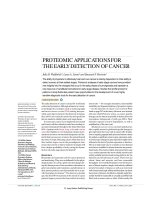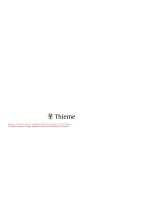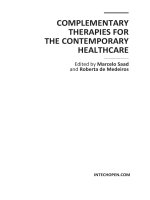Tài liệu Complementary Therapies for the Contemporary Healthcare pptx
Bạn đang xem bản rút gọn của tài liệu. Xem và tải ngay bản đầy đủ của tài liệu tại đây (7.21 MB, 244 trang )
COMPLEMENTARY
THERAPIES FOR
THE CONTEMPORARY
HEALTHCARE
Edited by Marcelo Saad
and Roberta de Medeiros
Complementary Therapies for the Contemporary Healthcare
Edited by Marcelo Saad and Roberta de Medeiros
Contributors
Roberta de Medeiros, Marcelo Saad, Trisha Dunning, Vilelmine Carayanni, Anson Chui Yan
Tang, Graham Wilfred Ewing, Vitor Engrácia Valenti, Luiz Carlos de Abreu, Heraldo L. Guida,
Luiz Carlos M. Vanderlei, Lucas Lima Ferreira, Celso Ferreira, Maria Franco Trindade Medeiros,
Luci de Senna-Valle, Regina Helena Potsch Andreata, Kalavathy Ramasamy, Zuhailah Mohd
Shafawi, Vasudevan Mani, Ho Yin Wan, Abu Bakar Abdul Majeed, Bowirrat Abdalla,
Mustafa Yassin, Menachem Abir, Bishara Bisharat, Zaher Armaly
Published by InTech
Janeza Trdine 9, 51000 Rijeka, Croatia
Copyright © 2012 InTech
All chapters are Open Access distributed under the Creative Commons Attribution 3.0 license,
which allows users to download, copy and build upon published articles even for commercial
purposes, as long as the author and publisher are properly credited, which ensures maximum
dissemination and a wider impact of our publications. After this work has been published by
InTech, authors have the right to republish it, in whole or part, in any publication of which they
are the author, and to make other personal use of the work. Any republication, referencing or
personal use of the work must explicitly identify the original source.
Notice
Statements and opinions expressed in the chapters are these of the individual contributors and
not necessarily those of the editors or publisher. No responsibility is accepted for the accuracy
of information contained in the published chapters. The publisher assumes no responsibility for
any damage or injury to persons or property arising out of the use of any materials,
instructions, methods or ideas contained in the book.
Publishing Process Manager Dragana Manestar
Typesetting InTech Prepress, Novi Sad
Cover InTech Design Team
First published October, 2012
Printed in Croatia
A free online edition of this book is available at www.intechopen.com
Additional hard copies can be obtained from
Complementary Therapies for the Contemporary Healthcare,
Edited by Marcelo Saad and Roberta de Medeiros
p. cm.
ISBN 978-953-51-0801-6
Contents
Preface IX
Section 1 Current Scenario 1
Chapter 1 Complementary Therapies – Considerations
Before Recommend, Tolerate or Proscribe Them 3
Roberta de Medeiros and Marcelo Saad
Chapter 2 Integrating Complementary and Conventional Care
Using Quality Use of Medicines as a Framework 17
Trisha Dunning
Chapter 3 Evaluating Homeopathic Therapies
for Contemporary Health Care: An Evident Priority 33
Vilelmine Carayanni
Section 2 Diagnostic Resources 59
Chapter 4 Review of Traditional Chinese Medicine
Pulse Diagnosis Quantification 61
Anson Chui Yan Tang
Chapter 5 Does the Cognitive Top-Down Systems Biology Approach,
Embodied in Virtual Scanning, Provide Us with
a Theoretical Framework to Explain the Function
of Most Complementary and Alternative and
Most Orthodox Biomedical Techniques? 81
Graham Wilfred Ewing
Chapter 6 Musical Auditory Stimulation
and Cardiac Autonomic Regulation 111
Vitor Engrácia Valenti, Luiz Carlos de Abreu, Heraldo L. Guida,
Luiz Carlos M. Vanderlei, Lucas Lima Ferreira and Celso Ferreira
Chapter 7 Spiritual-Religious Coping –
Health Services Empowering Patients’ Resources 127
Marcelo Saad and Roberta de Medeiros
VI Contents
Section 3 Therapeutic Resources 145
Chapter 8 Botanical Species as Traditional Therapy:
A Quantitative Analisys of the Knowledge
Among Ranchers in Southeastern Brazil 147
Maria Franco Trindade Medeiros, Luci de Senna-Valle
and Regina Helena Potsch Andreata
Chapter 9 Hypocholesterolaemic Effects of Probiotics 163
Kalavathy Ramasamy, Zuhailah Mohd Shafawi,
Vasudevan Mani, Ho Yin Wan and Abu Bakar Abdul Majeed
Chapter 10 Traditional and Modern Medicine Harmonizing
the Two Approaches in the Treatment of Neurodegeneration
(Alzheimer’s Disease – AD) 181
Bowirrat Abdalla, Mustafa Yassin, Menachem Abir,
Bishara Bisharat and Zaher Armaly
Chapter 11 Distant Healing by the Supposed Vital Energy –
Scientific Bases 213
Marcelo Saad and Roberta de Medeiros
Preface
The concepts of health, illness and healing have evolved over the centuries. But it was
always a concern of humanity to eliminate suffering and prevent death. The resources
used for these purposes were evolving as knowledge about the nature of the diseases
improved. Modern medicine achieved amazing progresses but, in recent years, many
patients have expressed their dissatisfaction with the conventional healthcare because
of its increasingly technical approach, morbidity by the side effects of treatment and
the absence of cure for certain diseases.
Complementary therapies (CTs) are practices, products or systems for health that are
outside the domain of conventional medicine (also called Western or allopathic
medicine), used either to treat illnesses or to promote health and well-being. Defining
CTs is difficult, because the field is very broad and constantly changing. The list of
what is considered CT changes continually, and therapies whose safety and
effectiveness are demonstrated may become part of conventional medicine.
The number of patients who question their general practitioners about CTs increases
continuously. These therapies complement the conventional medicine by fulfill
demands not attended by the standard approach and by diversify the conceptual chart
of medicine. An approach oriented for a broader meaning of cure (physical, mental,
emotional, social and spiritual) should combine in a coordinated way treatments from
conventional medicine and CTs for which there is some high-quality evidence of
safety and effectiveness.
Modernly, this is achieved by the "Integrative Medicine" approach. This is aligned to
the concept of patient-centered healthcare, which is the provision of what an
individual needs particularly. It is a model of care that promotes patient recovery at all
levels. However, there are several issues still unanswered in the field of CTs, that
include: How does it work? Will it interact with conventional medical treatments
already in use? What objective benefits can be expected? Do the potential benefits
outweigh the potential risks? How long must the treatment last?
In order to walk towards a balanced situation in the field of CTs, we need to ask and
answer questions that generate useful directions. Using a SWOT analysis (Strengths,
Weaknesses, Opportunities, Threats), we may risk to frame the current scenario and to
X Preface
project the possible future of CTs. Besides the here listed strengths, opportunities,
weaknesses and threats, there must be many others.
1. STRENGTHS are characteristics that give to the issue an advantage. This item has
to do with survival. Key questions for this issue include: What are our advantages?
What other people see as our strengths? What we do exceptionally well? What
valuable assets do we have? We may identify at least two major Strengths of CTs: the
public preference and the ancient tradition.
1.1. Public Preference. The interest in CTs among patients is increasing worldwide.
One of the main reasons is a growing trend for patients to take a more proactive
approach to their own health. Patients also focus self-care to prevent diseases and
improve quality of life. Also, some individuals feel some frustration with the
dominant health care system. The patients expect that the health services respect and
support their willing about CTs, following the model of patient-centered care. Many
people are prone to pay for CTs out-of-pocket to be treated in a more holistic way.
1.2. Ancient Tradition. Many CTs have originated hundreds or thousands years ago,
and have successfully survived till our days. This only fact may be viewed as a proof
of value of these techniques, which deserves the due respect. The ancestral root of
many CTs produces a great appeal for the ancient knowledge they save.
2. WEAKNESSES (or Limitations) are characteristics that place the issue at a
disadvantage. This item has to do with maintenance. Key questions for this issue
include: What do we do badly? What should we avoid? There are weak links in the
chain? What could we do better? From what we are criticized? Where are we
vulnerable? We may identify at least two major Weaknesses of CTs: the “mystique”
language and the unpredictability of outcomes.
2.1. “Mystique” language. Communication is a weak point in CTs. The concepts of the
techniques are often elaborate, transcending biophysical models and employing the
principles of salutogenesis. Terms as “prana” and “chi”, among many others, don’t
correlate to modern biologic concepts. This gap reinforces the skepticism among
scientists. Also there are some misunderstandings, such thinking that "every natural
product must be healthy", hiding the fact that, as with any medical treatment, there
can be risks with some CT.
2.2. Unpredictability of Outcomes. The lack of uniformity on the patients’ responses
to CTs is responsible for many reports of bad results on researches. Many CTs work
well for some patients while don’t work at all for others. There may be factors
determining these differences, which remain still unknown because these factors must
be beyond the data obtained from randomized double-blind clinical trials.
3. OPPORTUNITIES are external chances to improve performance. This item has to
do with growth. Key questions for this issue include: What are the good opportunities
Preface XI
ahead? In which emerging trends can we capitalize? What are the opportunities not
still addressed? We may identify at least two major Opportunities of CTs: better
general acceptance and the need for low-cost healthcare.
3.1. Better General Acceptance. The interest in CTs arrived to universities, which
encourages high level academic studies in this field. Currently, there are many
valuable scientific journals dedicated to publish articles about CTs. Some respected
healthcare institutions started to offer many CTs techniques besides conventional
treatments.
3.2. Need for Low-Cost Healthcare. All over the world, governments face difficulties
to maintain the current financial investment in healthcare. At same time, there is a
growing body of evidence indicating that CTs are making a significant and cost
effective contribution to the health of the community, especially in chronic disease
management and prevention of diseases.
4. THREATS are external elements that could cause trouble. This item has to do with
development. Key questions for this issue include: Do we have all the necessary skills?
Deficiencies can make us critically vulnerable? What obstacles ahead can block
progress? There are changes coming in our field? We may identify at least two major
Strengths of CTs: the charlatanism by some practitioners and the prejudice and
disinterest from health professionals.
4.1. Charlatanism by Some Practitioners. Charlatans may be motivated either by
greed or ignorance. Anyway, some practitioners of CTs make exaggerated claims
about curing diseases, and some ask their patients to abandon the conventional
treatment. For these reasons, many doctors are conservative about recommending
CTs. Challenges include also the user behavior. Patient may seek CTs for wrong
motivations, as a shortcut to resolve problems. The results may include from
disappointment to retardation of clinical investigation, with serious consequences.
4.2. Prejudice and Disinterest from Health Professionals. Many people ridicule CTs
even before to collect all information for a critical analysis. The attachment to
conventions results from the sloth to remain in a comfort zone. As a rule, health
professionals don't receive training in CTs, so they may not feel comfortable making
recommendations or addressing questions in this area. Many physicians are familiar
with acupuncture or chiropractic, but are not quite sure how to respond to patients
who ask for music therapy or Reiki.
Based on the above facts, we could propose some actions to support the development
of CTs and their integration to conventional care. Figure 1 represents the framing of
the CTs question and illustrates the actions to support a full integration with
conventional healthcare.
XII Preface
Figure 1. SWOT representation for CTs (black squares), strategies for improvement (grey arrows)
and actions required (dotted squares).
Strategy A - Maximize success by identifying matching Strengths and
Opportunities. The main action for this purpose is financial support for research.
One reason for the lack of research in CTs is that large, carefully controlled medical
studies are costly. Trials for conventional therapies are often funded by large
companies that develop and sell drugs. Fewer resources are available to support trials
of CTs. Governments, universities, independent institutions and professional
associations must join resources to solve this gap.
Strategy B - Identify Strengths that may reduce the effect of Threats. The main action
for this purpose is education of healthcare professionals. Because of the increased use
of CTs, all health professionals need to be familiar with this subject so they can assist
clients to make informed decisions in the use of these therapies. Although many health
professionals are developing a favorable opinion toward CTs, they commonly have
difficulty to supply orientation for patients about benefits and risks, limitations and
characteristics of the techniques, due to lack of training. The body of evidences about
the efficacy and the security of the diverse modalities of CTs is dynamic and request
constant updating by the health professionals.
Strategy C - Identify Opportunities that may reduce the effect of Weaknesses. The
main action for this purpose is establishing common ground. CTs must be integrated
STRENGTHS
- Public
Preference
- Ancient
Tradition
WEAKNESSES
- “Mystique”
Language
- Unpredictable
Outcomes
OPPORTUNITIES
- Be�er Scientific
Acceptance
- Need Low-Cost
Healthcare
THREATS
- Charlatanism by
Some
- Prejudice and
Disinterest
[C]
Identify
Opportunities
that may reduce
the effect of
Weaknesses
[A]
Maximize success by
identifying matching
Strengths and
Opportunities
[D]
Minimize failure by
identifying matching
Weaknesses and
Threats
[B]
Identify
Strengths that
may reduce effect
of Threats
Standardization
of Procedures
Financial Support
for Research
Education of Health
Professionals
Establish
Common Ground
Preface XIII
to conventional healthcare in a cooperative, non-competitive way. Advances in
physiologic knowledge will act as a bridge linking the biologic facts with the proposals
of CTs. For many complementary therapies is almost impossible to conduct this type
of study, due to the difficulty in creating a control group. Alternative ways to validate
CTs must be explored.
Strategy D - Minimize failure by identifying matching Weaknesses and Threats.
The main action for this purpose is standardization of procedures. There is no
standardized system for credentialing CTs practitioners, as a whole, to provide
services. The extent and type of credentialing vary greatly among regions and from
one CT profession to another. In different countries, a same product may be labeled as
food supplement or as medication. A safe, ethical, efficacious treatment with CTs can
only be offered when fully incorporated into conventional healthcare. An orthodox
clinical diagnosis must be established, to make sure that not only the symptoms are
being treated, but also their causes.
To conclude, we foresee an epoch when CTs may complete the definition of health
adopted by the World Health Organization (WHO): "a state of complete physical,
mental and social well-being, and not merely the absence of disease or infirmity." This
definition was adopted during the founding of this entity in 1948, and has not been
modified since then. In the late 1970s, the WHO created the Traditional Medicine
Program. Since then, the WHO expressed its commitment to encourage Member States
to formulate and implement public policies for integrated and rational use of
traditional medicine and CTs in the national health care as well as the development of
scientific studies.
We hope the information from the present book can collaborate in some manner with
the ongoing process of evolution of the paradigms related to concepts of health,
disease and healing.
Marcelo Saad, MD, PhD
Acupuncturist at Hospital Israelita Albert Einstein
Director of S. Paulo Medical College of Acupuncture,
S. Paulo
Brazil
Roberta de Medeiros, Biologist, PhD
Full Professor of Physiology at Centro Universitario S. Camilo
S. Paulo
Brazil
Section 1
Current Scenario








